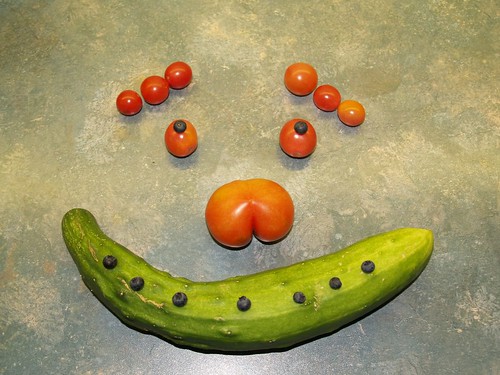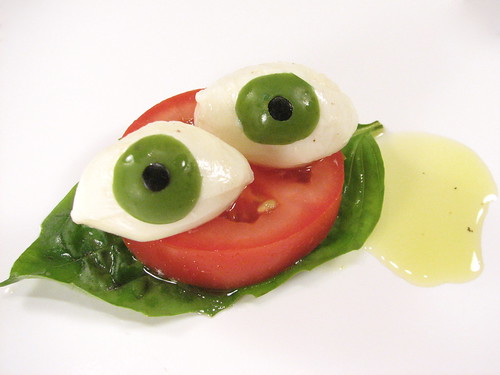The Role of Fruits & Vegetables in Mental Health Research Intensifies
Crossing the border into the state of bliss can be as elusive as it is subjective. We might find joy in a chocolate cake today and in a visit with an old friend tomorrow. But regardless of the source of our smiles, most of us can agree that happiness is the result of positive feelings – joy, pleasure, satisfaction – and the absence of negative ones – like stress and depression – and it’s something all of us want more of. But in our endless pursuit of positive feelings, we might be overlooking a source of good cheer that’s right in front of us: our daily intake of fruits and vegetables.
Or was there? Is the idea that happiness is within our reach (and on our plates) groundbreaking? Or just old news?
The Research
The happiness study in question hinges on research conducted in Britain and slated for publication in Social Indicators Research. As part of the study, men and women ate from 0-8 servings of a variety of fruits and vegetables and reported on things like life satisfaction and feeling “low” as measures of their well being. The researchers found that the participants’ happiness improved the more fruits and veggies they ate, reaching their peak at 7 or 8 servings.
The effect of fruits and vegetables on mood was measurable and significant. And researchers involved in the study suggest a biochemical effect, not a psychological one. We already know that proper nutrition is important in preventing disease and slowing the aging process – but the case for nutritionally-dense food influencing our emotional state is compelling.
Unpacking the Food-Mood Relationship
There is a dearth of research into the effect of fruit and vegetable intake on emotional health. We know a great deal, however, about the relationship between nutritionally dense foods and the brain, a likely locus of happiness. For example:
- Cups of fruit such as antioxidant-rich berries are known to help keep the mind clear and focused – this may contribute to happiness, or allow us to handle daily stressors better, which increases our happiness quotient.
- Food can affect blood glucose levels, or trigger food sensitivities which can affect the way we feel, causing feelings of lethargy and illness.
- Food could affect brain chemistry, too. Some researchers have found that increased levels of depression, anxiety, mood swings, hyperactivity and a wide variety of other mental and emotional problems can be tied to nutrition. (The first trial testing whether a healthy diet can improve the mental health of people with depression is planned by researchers is already in the works).
- Researchers continue to demonstrate protective effects of phytochemicals (found in high concentrations in wild blueberries) on the brain, and the body of research in the field of neuroscience supporting the benefits foods high in phytos is growing. Recent studies led by Dr. Robert Krikorian at University of Cincinnati, for example, suggest that regular consumption of wild blueberries may slow the loss of cognitive function and decrease depression in the elderly.
While these things contribute to our understanding of the connection between fruits and vegetable and happiness, researchers have yet to fully understand the reason for the results revealed in the Britain study. Until we know more about the impact of fruits and veggies on mood, pleasure, and mental illness, we might be best served to conduct a little research on ourselves.
Forging a Path to Happiness
What is your diet doing (or not doing) for your happiness quotient? It might be time to take a closer look.
Starting a food diary is the best way to research your own food-mood connection. Writing down what you eat will increase your awareness of your food intake and help you discern patterns between diet and things like energy levels, mood and feelings of well being. USDA Dietary Guidelines recommend “filling half your plate with fruits and vegetables at every meal” with the goal of 2 cups of fruit and 3 cups of vegetables, on average, for a total of 5 cups every day. By tracking what you eat every day, you’ll see if you fall short of the USDA recommendations and by how much.
Once you’ve tracked your diet for a week or so, make a change. Start by getting two cups of fruit a day, for example, or eliminate processed foods in favor of a fruit or vegetable. Evaluate the impact of this change on your mood, your sleep, and your stress level. While the kick of endorphins after eating something sugary, salty, or fatty is obvious, we can sometimes miss its cost to our general feelings of happiness and well being.
Get Happy – 5 Ways to Get Your 5
- Start small. Starting at zero? Ease in with ½ cup of fruit, berries, or greens twice a week. Then, move to ½ cup every day. Baby steps make it easier to attain the recommended goal of 2 cups of fruit per day and 5 total cups of fruits and vegetables over the long term.
- Sneak ’em. If you prefer to sneak fruits and veggies into your diet, kale chips and cauliflower popcorn were invented just for you. While whole fresh or fresh frozen foods are best, moving away from processed snacks in favor of homemade ones is a great way to start the process. Or, give a green smoothie a go for a mega-dose of fruits and vegetables masked as deliciousness.
- Replace something. Having chips with lunch? Slice some carrots instead. Late-night ice cream a routine? Swap it for a ½ cup of fresh berries.
- Choose what you like. Keen on tomatoes? Kiwis your weakness? Eating plenty of what you really like makes racking up the cups easy.
- Bathe your meal in berries. Steven Pratt, author of the groundbreaking book on nutrition, SuperfoodsRx, suggests we “bathe our meals in berries” for optimal nutritional benefit and disease prevention. Berries such as wild blueberries have a high concentration of beneficial phytochemicals, making them more powerful than most other fruits when it comes to disease prevention. Douse a piece of fish with wild blueberry sauce, pair salads with berries, or cover desserts and breakfasts with them – using fresh frozen wild blueberries from the freezer (look for them in the frozen food section) is a convenient way to make them available by the cup at every meal.
A Month of Mood Boosters: Check out our month of ideas for incorporating fruits and vegetables into your meals – one for every day – or get started on your own list. Then, give us a comment that includes your favorite way of getting 5 cups a day. We might include it in an updated Month of Fruits and Veggies post!
Photo courtesy of  by estoril.
by estoril.





